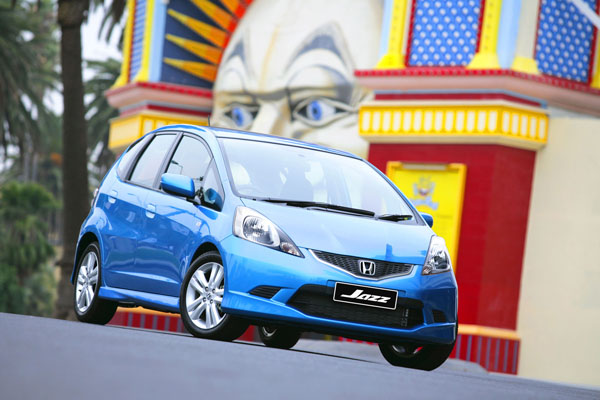Jazz is the smallest Honda model that’s sold in Australia. It was initially launched here in October 2002, but we will only cover from the second generation of September 2008 in this review.
Not only is the 2002 getting on years but the 2008 is significantly larger to make it more suited to adults in the rear seats. It has better in-cabin refinement and overall equipment levels. Handling was given a slightly more sporty feeling though, as it’s intended as a city car, the emphasis still leans to the comfort side of the equation.
An emphasis on reducing fuel consumption and exhaust emissions pleased many buyers.
Honda Jazz in its four generation reached us in July 2017, it’s still relatively new to cover in detail as a used car. Suffice to say that, yet again, it’s longer than before to provide added room. It’s also smoother and quieter to ride in.
Comfort in the little Honda is good if roads are reasonably smooth, but it can be bounced about on bumps. Keen drivers may find it a little lacking in steering precision.
Honda Jazz has a high roofline to maximise interior space in what is a relatively small body. It can seat four adults without too much compromising on legroom, something that was improved with each new generation. There’s reasonably easy entry to the back seat but try for yourself if elderly folks are likely to be travelling there.
Honda Jazz has a brilliant folding Magic Seat design. The seat slides backwards and forwards to let you choose between people and/or luggage. It can be folded in a few seconds to create a very large luggage area. The front passenger seat backrest can be reclined all the way down to let you carry long loads extending from the dashboard to the rear window.
If you want a Honda Jazz with a larger boot you can choose the Honda City which is effectively a Jazz with a four-door sedan rear end. It was usually introduced a few months later than the Jazz and hasn’t proven as popular as the hatch.
Honda Jazz comes with a 1.3- or 1.5-litre four-cylinder engine, though not every engine is offered in each model. Though the engine capacities remained in the second-generation Jazz, they were an all-new design. Power and torque were increased, yet fuel consumption and exhaust emissions came down. The torque graph was stretched to give more grunt at the bottom end of the rev range.
Manual and automatic transmissions are offered, some autos are CVTs, others use a traditional torque convertor. Manuals aren’t particularly popular and may be difficult to resell / trade in in years to come.
While the Jazz is reasonably easy for the amateur mechanic to work on, there is some underbonnet crowding that’s inevitable on a car of this size. As always have a workshop manual at your side and don’t attempt any safety related work.
The Honda Australia dealer network is widespread in the heavily populated areas, but less so in remote areas.
We seldom hear of any real hassles with getting hold of spare parts. Parts prices are more reasonable these days than in the past.
Insurance costs for Honda Jazz (and City) generally sit in the mid-range. There doesn’t appear to be any major differentiation between companies on premium charges. It’s always wise to spend some time shopping around for the best deal, but make sure you do accurate comparisons.
WHAT TO LOOK FOR
As always, it makes a lot of sense to get a professional inspection after carrying out initial checks to the best of your ability.
Check that the engine starts easily and responds quickly and positively to the throttle, even when it’s completely cold.
A continuously variable transmission (CVT) should react quickly to changes in throttle position and road conditions. As a CVT sounds and feels different to conventional automatics, have an expert drive it if you are not confident it’s working correctly.
Sluggish changes on the conventional automatic transmission may mean expensive problems.
We have seen damaged seals on the hatch lids that have led to water damage on the boot floor. Also check the underfloor compartment.
Look over the interior to make sure it hasn’t suffered at the hands of uncaring owners, especially bored young kids.
Bodywork should be undamaged and free from rust. Corrosion is not common unless the car has been poorly repaired after a smash.
HOW MUCH?
Set your budget around spending from $2000 to $4500 for a 2008 Honda Civic VTi; $3000 to $6000 for a 20102 City VTi-L; $4000 to $7000 for a 2010 Civic VTi or a 2012 Civic Vibe; $6000 to $10,000 for a 2012 Civic VTi-S or a 2014 City VTi-L; $8000 to $12,000 for a 2014 Civic Vibe-S; $10,000 to $15,000 for a 2015 Civic VTi-L; and $13,000 to $19,000 for a VTi-L.
CAR BUYING TIP
Small city cars often suffer from more bumps and grinds than their country cousins. An are often running with their engines below full operating temperature. So don’t be fooled into thinking a low km reading is a good thing.
RECALLS: To browse recalls on all vehicles go to the ACCC at: www.productsafety.gov.au/products/transport/cars/
